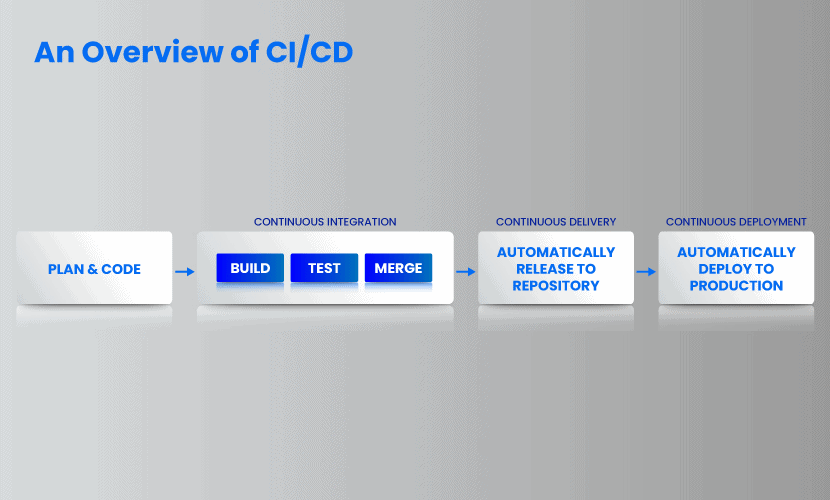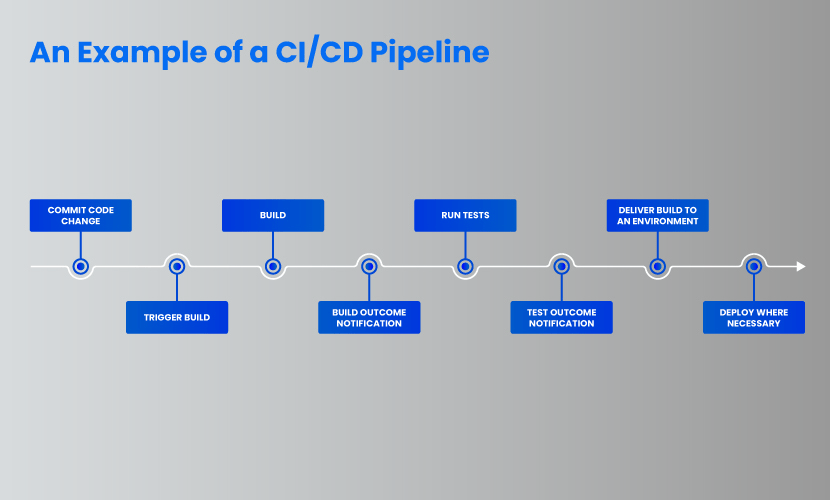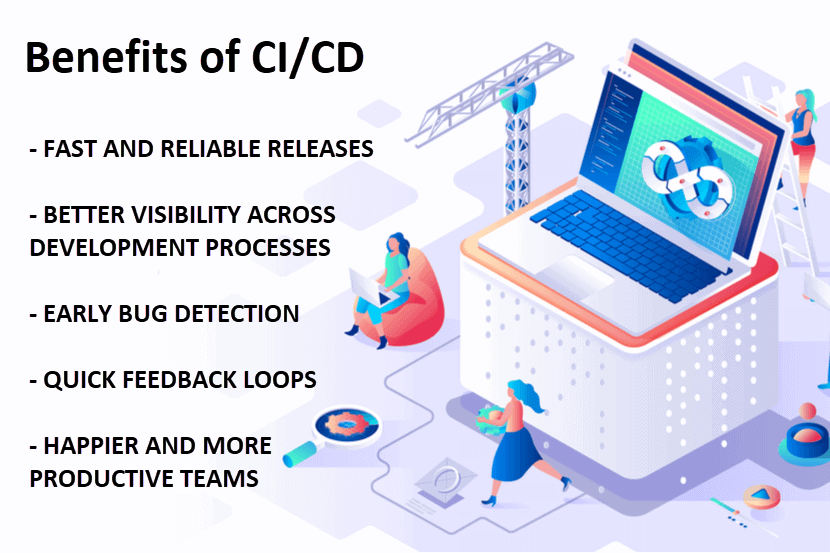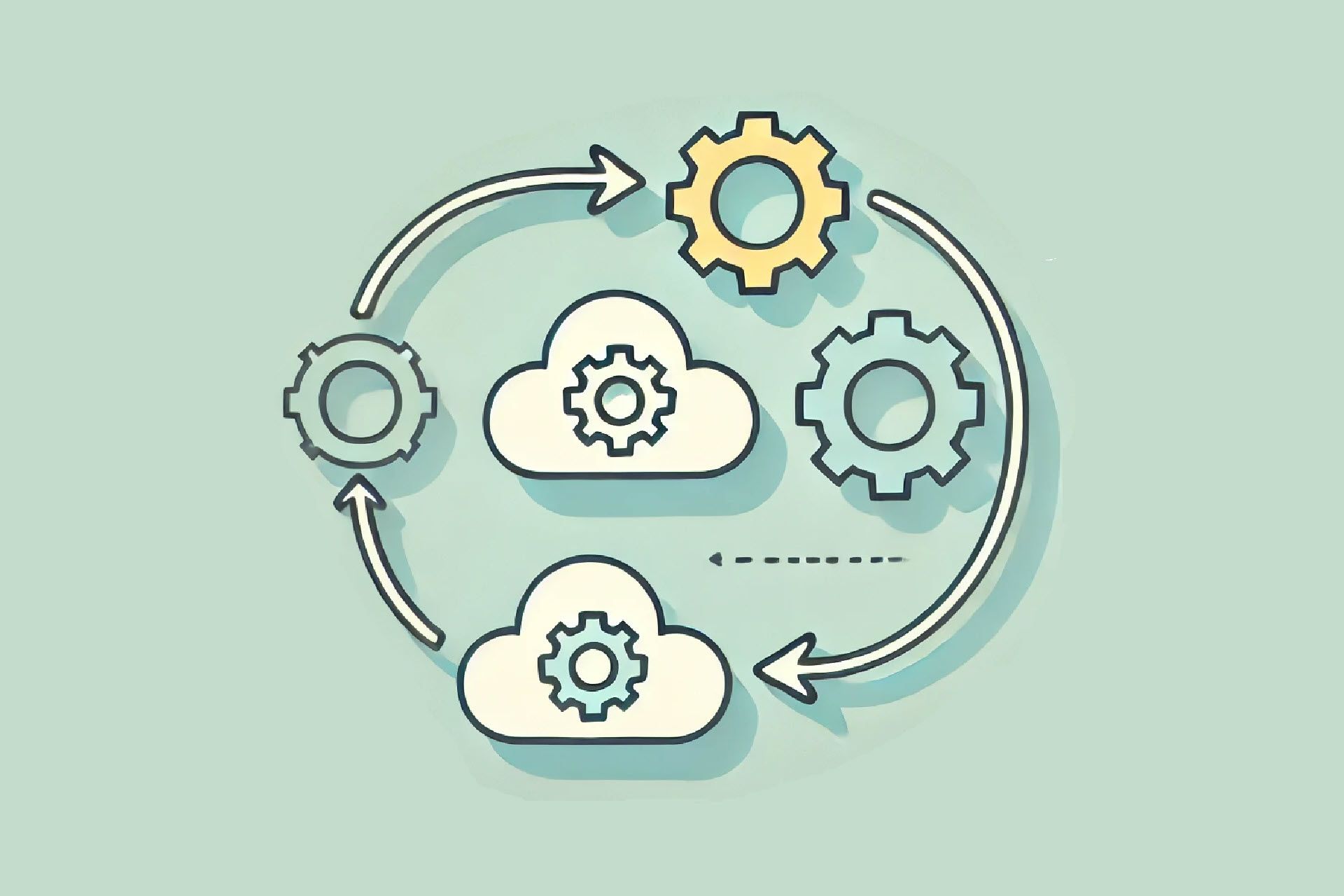CI/CD enables development teams to deliver software updates more frequently and reliably. This Agile and DevOps practice grants companies the agility to keep up with business goals and customer needs.
This article covers the main concepts behind CI/CD. Read on to learn how automatic release pipelines benefit both developers and companies.
What is CI/CD?
CI/CD is a set of practices that automate the building, testing, and deployment stages of software development. Automation reduces delivery timelines and increases reliability across the development life cycle.
The CI in CI/CD stands for continuous integration. The CD refers to continuous delivery or continuous deployment, depending on how the team chooses to push code changes to production.
Note: Learn the difference between continuous integration, delivery, and deployment to see how each practice optimizes stages in the development pipeline.
Continuous integration and continuous delivery are two distinct processes in CI/CD and have different purposes:
- CI runs automated build-and-test steps to ensure that code changes reliably merge into the central repository.
- CD provides a quick and seamless method of delivering the code to end-users.
The goal of CI/CD is to help developers ship software with speed and efficiency. The team continuously delivers code into production, running an ongoing flow of new features and bug fixes.

Continuous Integration (CI) Explained
Continuous integration is the practice of continually integrating updates into a codebase. CI offers a consistent, automated process of building, packaging, and testing new software.
With CI, developers commit code changes (whether corrective or innovative) into a shared repository. The updates are always small, making them easy to track. Each new integration triggers an automatic build-and-test sequence. This process provides quick feedback to the developer and notifies about any errors.
Ideally, the CI feedback loop should not take longer than 10 minutes. Builds and merges should happen as often as possible, ideally multiple times a day.
CI is ideal for big projects with numerous developers working independently on complex applications. Automatic builds allow the team to avoid merge conflicts, bugs, and duplicate efforts.
Continuous Delivery (CD) Explained
Continuous delivery starts where continuous integration ends. CD enables developers to deploy regular software changes (new features, improvements, bug fixes) to different environments and end-users at any time.
All code that enters the CD process must go through CI first.
Smaller, more frequent software releases are less disruptive and are easier to troubleshoot or rollback in case of an issue. The team also has the ability to rapidly deliver new features, helping the company better meet customer needs.
Continuous Testing Explained
Continuous testing is the practice of running automated tests, while code changes go through CI and CD. A single CI/CD process can have many types of tests:
- Unit testing (a CI test that ensures individual functions perform correctly during the build process)
- Integration testing (checks if components and services all work together)
- Functional testing (ensures that the feature performs as the team expects)
- Acceptance testing (performance, scalability, stress, capacity, etc.)
- Static code analysis (checks for syntax issues and vulnerabilities)
- Automated tests like API testing and security testing
Not every CI/CD process has all these tests, but the goal of continuous testing is always the same. Continuous testing finds problems quickly and alerts the team before a bug causes an issue in production.
What is a CI/CD Pipeline?
A CI/CD pipeline is a runnable, step-by-step path all software follows during its development lifecycle. A typical pipeline builds code, runs tests, and safely deploys a new version of the application.
Automated pipelines provide teams with several benefits:
- Fast deployment of new software updates
- Reliable build and test processes
- Fewer bugs and errors end up in production
- Transparent logs of all code changes, tests, and deployments
CI/CD pipelines do not alter the way developers create software. In the absence of an automated pipeline, engineers would still need to perform the same steps manually. The manual approach is less productive, though, as the team must focus more on repetitive tasks and fixing errors instead of writing software.

CI/CD Pipeline Stages
A typical CI/CD pipeline has four main stages: commit, build, test, and deployment.
| Commit Stage | A source code repository triggers the pipeline after a commit. | Integration merges new features and updates with the codebase. | Developers get feedback on the quality of the new code. | CI/CD tools run unit and integration tests to check for potential problems. |
| Build Stage | The second stage begins after the initial testing is over. | If necessary, the process compiles the programs (typical for Java, C/C++, and Go code), and the pipeline builds containers. | The pipeline combines the code and dependencies to create a runnable instance of the software. | If this step fails, there is an issue with the code (or its dependencies), and developers must address the problem before continuing. |
| Test Stage | This stage is a safety net that prevents unusual bugs from reaching the end-users. | Automated tests validate the correctness of the code. | Automated tests check the behavior of the product. | The pipeline gives feedback to developers and reports on the state of new code changes. |
| Deployment Stage | If code changes pass the test stage, the pipeline launches the final deployment phase. | The application goes live. | There are usually multiple deploy environments besides the production environment reserved for end-users. | Real-time monitoring ensures new features act as predicted. |
A common practice is to set up notifications at the end of each stage. Alerts and reports at critical points keep team members in sync.
The testing stage tends to change the most between different pipelines. Depending on project size, the testing stage can last from seconds to hours. Some large projects even run tests in multiple phases. In that setup, the tests typically run in parallel to save time.
More complex pipelines have additional steps besides the four core ones, such as data synchronization, application and library patching, or archiving information resources.
Benefits of CI/CD
Quicker, More Reliable Releases
CI/CD speeds up the development process and allows the product to reach the user quickly. A pipeline also reduces the risk while building code, allowing developers to focus on coding instead of fixing errors.
Greater Visibility
A CI/CD pipeline allows teams to analyze builds and test results in detail. Greater transparency reveals potential areas of improvement in the development process. Developers easily navigate across stages, find inefficiencies, and optimize the process to increase productivity.
Early Bug Detection
Various types of automated tests identify most bug issues at an early stage. Between automatic tests and manual QA checkups, CI/CD leaves little room for last-minute bug surprises.
Fast Feedback Loops
Delivering updates at a quick rate leads to constant user feedback. Take advantage of user input by A/B testing features and experimenting with early versions of products with users.
Happier Dev and Ops Teams
CI/CD allows developers to push code changes with fewer manual tasks and less error-fixing. Operations teams enjoy stability due to standardized environments, tests in the delivery process, separate environment variables, and automatic rollbacks.

The Main Principles of CI/CD
Embrace Automation
A manual process is not repeatable or reliable until you commit it to code and make it executable on demand. A team should automate as many processes as possible, including tests, releases, and configuration changes.
Optimize Your Testing Strategies
A standard CI/CD setup runs different tests in parallel to reduce testing time. However, the team should not run all test types at the same time. For example, there is no sense in running time-consuming UI tests if a basic unit test failed previously.
Set up your pipeline to have multiple stages in which fast and fundamental tests (security scanning, unit tests, etc.) run first. Once the code passes the initial tests, the pipeline is ready to run integration, API, and UI tests.
Use Consistent Environments
A CI/CD pipeline is not reliable if each run modifies the environment. Start each workflow from the same isolated environment and ensure consistency between projects.
Version Control Everything
Version control allows you to track code changes and revert to earlier deployments when necessary. Configurations, scripts, databases, and documentation should go through version control to track edits and ensure consistency.
Git is the most popular VCS (Version Control System) on the market. If you want to learn more about how Git works, read the following articles:
How To Install and Use Git On Windows
Git Commands Cheat Sheet (Downloadable Cheat Sheet)
How to Undo Last Commit in Git
How To Unstage Files On Git
How to Switch Git Branch
Run Regression Tests in Local Environments
The team should run all or a subset of regression tests in their local environments. Local tests ensure that developers only commit code after regression tests examine the changes. This practice helps troubleshoot problems before the code reaches other developers.
Use Infrastructure as Code (IaC)
Efficient CI/CD relies on flexible and consistent infrastructure deployment. Infrastructure as Code (IaC) enables developers to provision IT environments with automated scripts.
IaC is an essential DevOps practice that removes issues of manual infrastructure setups and configuration drifts.
Develop in Small Iterations
The team should work in small iterations. If you develop in feature branches, they should not live longer than a day. If the update requires more time to develop, use feature flags but keep iterations small.
Always Search for Areas of Improvements
Measure how long it takes the team to build code and enter production. Key DevOps metrics help you understand whether the team delivers value to users quickly and which stages of the pipeline need optimizations.
You should also monitor the effectiveness of each deployment. The feedback loop helps measure metrics like business revenue, user conversion rates, and engagement time. Use these statistics to identify improvement opportunities and work them into your pipeline.
Boost Pipeline Security
Pipelines contain valuable data and have access to a centralized repository. Take the necessary measures to ensure optimum security of your CI/CD system.
Depending on your risk level, consider using advanced identity and privileged access management systems and VPNs for access.
The Best CI/CD tools
A CI/CD tool helps DevOps teams create a pipeline and automate integration, deployment, and testing stages. Here is a list of the most popular CI/CD tools you can choose from:
- Jenkins: An automation server that can handle anything from simple CI to a complex CI/CD pipeline.
- TeamCity: A CI server that helps build and deploy projects with reusable settings and configurations.
- Spinnaker: An open-source CD platform ideal for multi-cloud environments.
- GoCD: A CI/CD server that emphasizes modeling and visualization.
- CircleCI: A flexible, cloud-based CI/CD tool perfect for smaller projects.
- Travis CI: A Ruby-based tool with a robust build matrix.
- Bamboo: A CI server with support for several top stacks (Docker, AWS, Amazon S3, Git, CodeDeply, Mercurial) and up to a hundred remote build agents.
Note: Read about the 22 best CI/CD tools on the market and find the one that fits your team the best.
Most pipelines also include a variety of DevOps tools that are not strictly for CI/CD. Tools for container runtimes (Docker, rkt), container orchestration (Kubernetes), and configuration automation (Ansible, Chef, Puppet, etc.) regularly show up in CI/CD workflows.
A Faster, More Reliable Way to Build Software
A more robust development cycle that accelerates software delivery is crucial to staying competitive in the IT industry. Shift your team towards CI/CD to start developing software with more speed, precision, and impact.



